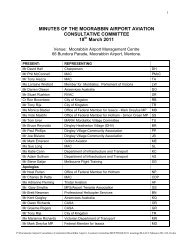Circuit Training at Moorabbin Airport Circuit Training at Moorabbin ...
Circuit Training at Moorabbin Airport Circuit Training at Moorabbin ...
Circuit Training at Moorabbin Airport Circuit Training at Moorabbin ...
Create successful ePaper yourself
Turn your PDF publications into a flip-book with our unique Google optimized e-Paper software.
A. Suggestion from MARA.<br />
To increase the height of the upwind leg as follows:<br />
• Upwind: Climb to 800 feet before turn.<br />
• Crosswind: Continue climb to 1,000ft<br />
• Downwind 1000ft descending to 500ft <strong>at</strong> base leg turn.<br />
• Base leg: 500 ft to final.<br />
B. Suggestion from Rosemary West.<br />
For the Eastern circuit, using 35R and 17L narrowing the circuit and making it longer. This<br />
would avoid entirely residential housing if the circuit was to oper<strong>at</strong>e as follows:<br />
• 17L departure: Upwind turn after Woodlands Golf Club (as is the case now for<br />
17R). Turn before Woodlands Drive and follow industrial est<strong>at</strong>e gap between<br />
Boundary Road and the freeway reserve.<br />
• 35R departure: Upwind turn after Capitol Golf Club and turn onto base <strong>at</strong><br />
Boundary Road. Again, follow industrial est<strong>at</strong>e gap between Boundary Road and<br />
the freeway reserve.<br />
• 13 and 31 departures: It is conceded there is no way to avoid residential areas<br />
overflight when runways 13 and 31 are in use.<br />
RVAC:<br />
We can’t see how extending the upwind leg will change anything in reducing the noise over<br />
Dingley. Aircraft will still follow the same flight p<strong>at</strong>h over the downwind leg as they are<br />
presently conducting. This procedure of conducting wide circuits is taught by some flying<br />
schools as part of their syllabus training and then forces others to follow. It is not a question<br />
of modifying existing circuits.<br />
<strong>Circuit</strong>s can quite easily be conducted remaining clear of Dingley Village. Extending the<br />
Upwind, base and final legs will not fix the problem. The problem lies with those aircraft<br />
which presently fly wide circuits causing others to follow. The importance of flying standard<br />
circuit p<strong>at</strong>terns is to emphasize to students the importance of staying close to an airfield<br />
especially below 1000ft AGL should the engine fail. Adopting the three degree approach p<strong>at</strong>h<br />
is wh<strong>at</strong> is considered important for standardis<strong>at</strong>ion purposes.<br />
MFT:<br />
Melbourne Flight <strong>Training</strong> is opposed to this concept. Although there would be no neg<strong>at</strong>ive<br />
cost impact I feel th<strong>at</strong> there is a safety impact.<br />
Pilots conduct their initial circuit training <strong>at</strong> <strong>Moorabbin</strong> <strong>Airport</strong>. The skills and procedures<br />
taught <strong>at</strong> this early stage of their training are the found<strong>at</strong>ion for their future flying. It is<br />
important th<strong>at</strong> pilots are accustomed to the standard circuit p<strong>at</strong>tern using visual cues so th<strong>at</strong><br />
when they move to different airports l<strong>at</strong>er in their training they can conform to the standard<br />
circuit p<strong>at</strong>tern.<br />
Any move to non‐standard circuit training would have a neg<strong>at</strong>ive safety impact but minimal<br />
effect economically.<br />
34




